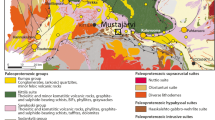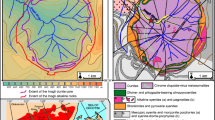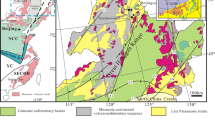Summary
The Golden Sunlight gold-silver telluride deposit, hosted primarily within the Mineral Hill breccia pipe (MHBP), is spatially related to a high-level, Late Cretaceous multiple intrusive, alkaline to subalkaline porphyry system. Base metal veins and manganese (rhodochrosite) mineralization occur up to 2km from the MHBP and form part of a regional mineral zonation pattern genetically related to a low-grade porphyry molybdenum system. Proterozoic rocks of the LaHood Formation and the informally named Bull Mountain Group host the MHBP and contain stratabound sulphides/ sulphosalts (up to 50% pyrite with minor to trace amounts of chalcopyrite, tennantite, pyrrhotite, sphalerite, galena, and molybdenite). Four periods of hypogene mineralization occur in the breccia pipe. Stages I and IV constitute ,≈99% of the mineralization; native gold (4–11 wt.% Ag), calaverite, tetradymite, tellurobismuthite, Se-bearing Bi sulphosalts (aikinite, lindströmite, krupkaite, gladite, bismuthinite, and ?benjaminite), tennantite (Zn, Fe, Te, and Bi varieties), coloradoite, melonite, galena (up to 6.7 wt.% Bi and 6.4 wt.% Se), stannite, chalcocite, and the rare mineral buckhornite are included in stage Ib. Minor amounts of base metals are present in stage II. Gold-silver tellurides (krennerite, petzite, sylvanite, and possibly the rare “x-phase”) developed in stage III whereas barite, fluorite, dolomite, magnesite, trace kaolinite, and sericite formed during stage IV. Utilizing the mineral assemblages in stage Ib, calculated values of logf Te2 and logf S2 range from -10.5 to -9.7, and -12.6 to -5.5, respectively.
Ore forming components (e.g., Au, Ag, Te, Cu, Bi, Mo, and much of the S) were likely derived from the Late Cretaceous intrusive system with possible contributions from the Proterozoic host rocks.
Zusammenfassung
Die Golden Sunlight Gold-Silber-Tellurid-Lagerstätte, die hauptsächlich im Brekzienschlot von Mineral Hill (Mineral Hill breccia pipe, MHBP) eingelagert ist, steht räumlich mit einem erzreichen, multi-intrusiven, alkalischen bis sub-alkalischen Porphyritsystem aus der Oberkreide in Beziehung. Erzadern und Mn-Mineralisation (Rhodochrosit) finden sich bis zu 2 km vom MHBP entfernt und sind Bestandteil einer regionalen Vererzung die genetisch zu einem erzarmen Mo-hältigen Porphyritsystem in Beziehung steht. Proterozoische Gesteine aus der LaHood-Formation und der inoffiziell benannten Bull Mountain Group umgeben den MHBP und enthalten schichtgebundene Sulfide und Sulfosalze (bis zu 50% Pyrit mit Neben- bis Spurenmengen von Kupferkies, Tennantit, Pyrrhotin, Zinkblende, Bleiglanz und Molybdänit).[▭
Der Brekzienschlot zeigt vier Phasen hypogener Mineralisation. Stufen I und IV enthalten ≈ 99% der Mineralisation: gediegen Gold (4–11 Gew.% Ag), Calaverit, Tetradymit, Tellurobismuthit, Se-hältige Bi-Sulfosalze (Aikinit, Lindströmit, Krupkait, Gladit, Bismuthinit und ?Benjaminit) Tennantit (Zn-, Fe-, Te- und Bi-Varietäten), Coloradoit, Melonit, Bleiglanz (mit bis zu 6.7 Gew.% Bi und 6.4 Gew.% Se), Zinnstein, Chalcocit, sowie das seltene Mineral Buckhornit treten in Stufe Ib auf. Geringere Mengen von Buntmetallen kommen in Stufe II vor. Gold-Silber-Telluride (Krennerit, Petzit, Sylvanit und möglicherweise die seltene “X-Phase”) sind in Stufe III ausgebildet und in Stufe IV wurden Baryt, Flusspat, Dolomit, Magnesit, Spuren von Kaolin und Serizit gebildet. Unter Verwendung der Mineralassoziationen der Stufe Ib lassen sich Werte von logf Te2 zwischen - 10.5 und - 9.7 und von logf S2 zwischen - 12.6 und - 5.5 errechnen.[▭
Die erzbildenden Komponenten (z.B. Au, Ag, Te, Cu, Bi, Mo und der Grossteil von S) stammen wahrscheinlich vom Intrusivsystem aus der Oberkreide, möglicherweise mit Beiträgen der proterozoischen Umgebung.[/ p]
Similar content being viewed by others
References
Afifi AM, Kelly WC, Essene EJ (1988) Phase relations among tellurides, sulfides, and oxides. I. Thermochemical data and calculated equilibria. Econ Geol 83: 377–394
Barton PB Jr, Skinner BJ (1979) Sulfide mineral stabilities. In:Barnes HL (ed) Geochemistry of hydrothermal ore deposits. Wiley-Interscience, New York, pp 278–403
Breskovska V, Tarkian M (1993) Mineralogy and fluid inclusion study of polymetallic veins in the Madjarovo ore field, Eastern Rhodope, Bulgaria. Mineral Petrol 49: 103–118
Cabri LJ (1965) Phase relations in the Au-Ag-Te system and their mineralogical significance. Econ Geol 60: 1569–1606
Chadwick TH (1992) Report to accompany Mineral Hill pit map and sections, 1:1200 scale, including discussions of the geology and gold targets in the pit and elsewhere in the district. Report to Golden Sunlight Mines Inc, 186 p (unpublished)
Charlat M, Lévy C (1974) Substitutions multiples dans la série tennantite-tetraédrite. Bull Soc franç Minéral Crist 97: 241–250
Chekalova KA, Slyusarev AP (1974) Find of seleniferous hammarite in the Orlovskoye deposit, Rudny Altai. Dokl Acad Sci USSR, Earth Sci Sect 216: 144–146
Chen TT, Kirchner E, Paar W (1978) Friedrichite, Cu5Pb5Bi7S18, a new member of the aikinite-bismuthinite series. Can Mineral 16: 127–130
Childs JF, Foster F (dy1993) A geologic summary of significant lode gold systems in Montana. Sc Mining Metall Explor Preprint 93-244, 40 p
DeWitt E, Foord EE, Zartman RE, Pearson RC, Foster F (1996) Chronology of Late Cretaceous igneous and hydrothermal events at Golden Sunlight gold-silver breccia pipe, southwestern Montana. US Geol Surv Bull 2155: 48 p
Donovan JJ, Rivers ML, Armstrong JT (1992) PRSUPR: Automation and analysis software for wavelength dispersive electron-beam microanalysis on a PC. Am Mineral 77: 444–445
Foord EE, Shawe DR (1989) The Pb-Bi-Ag-Cu-(Hg) chemistry of galena and some associated sulfosalts: a review and some new data from Colorado, California and Pennsylvania. Can Mineral 27: 363–382
——, ——Conklin NM (1988) Coexisting galena, PbSss and sulfosalts: evidence for multiple episodes of mineralization in the Round Mountain and Manhattan gold districts, Nevada. Can Mineral 26: 355–376
Foster F, Chadwick TH (dy1990) Relationship of the Golden Sunlight mine to the Great Falls Tectonic Zone. In:Moye FJ (ed) Geology and ore deposits of the Trans-Challis Fault System/Great Falls Tectonic Zone. Tobacco Root Geological Soc 15th Ann Field Trip Guide, pp 77–81
— (1997) Some observations regarding formation correlations and regional paleogeography of the southern Helena Embayment. Montana Bureau of Mines Spec Pub (in press)
—Nilsen TH (1997) Paleodepositional setting and synsedimentary mineralization in Belt Supergroup rocks of the Whitehall, Montana area. Montana Bureau of Mines Spec Pub (in press)
Foster F, Childs JF (1993) An overview of significant lode gold systems in Montana, and their regional geological setting. Explor Mining Geol 2: 217–244
Francis CA, Criddle AJ, Stanley CJ, Lange DE, Shieh S, Francis JG (1992) Buckhornite, AuPb2BiTe2S3, a new mineral species from Boulder County, Colorado, and new data for aikinite, tetradymite and calaverite. Can Mineral 30: 1039–1048
Herbert HK, Mumme WG (dy1981) Unsubstituted benjaminite from the AW Mine, NSW: a discussion of metal substitutions and stability. N Jahrb Mineral Monatsh: 69–80
Johan Z, Dódony I, Morávek P, Pašava J (1994) La buckhornite, Pb2AuBiTe2S3, du gisement d'or de Jilove, Republique tcheque. CR Acad Sci Paris 318 (série II): 1225–1231 (in French)
Johnson NE, Craig JR, Rimstidt JD (1986) Compositional trends in tetrahedrite. Can Mineral 24: 385–397
Kesler SE (1981) Mineralogical study of three pyrite concentrates (F-501, F-502, F-503) from Mineral Hill gold deposit, Montana. Report to Placer Dome, 53 p (unpublished)
Kiukkola K, Wagner C (1957) Measurements of galvanic cells involving solid electrolytes. Electrochem Soc 104: 379–386
Knittel U (1989) Composition and association of arsenian goldfieldite from the Marian gold deposit, northern Luzon, Philippines. Mineral Petrol 40: 145–154
Kostov I, Minčeva-Stefanova J (1982) Sulphide minerals - crystal chemistry, parageneses and systematics. Schweizerbart'sche Verlagsbuchandlung, Stuttgart
Kovalenker VA, Malov VS, Yevstigneeva TL, Vyal'sov LN (1984) Junoite and pekoite - first find in the USSR. Zap Vses Mineral Obshch 113: 35–43
Kovalenker VA, Zalibekyan MA, Laputina IP, Malov VS, Sandomirskaya SM, Gras'ko MI, Mkhitaryan DV (1990) Sulfide-telluride mineralization of the Megradzor ore field, Armenia. Int Geol Rev 32: 705–720
Legendre B, Souleau C, Hancheng C (1980) Le systém ternaire or-argent-tellure. Soc Chim Française Bull 1: 197–204
Lindquist AE (1966) Structure and mineralization of the Whitehall mining district, Jefferson County, Montana. Thesis, Montana Tech
Lowry D, Stephens WE, Herd DA, Stanley CJ (1994) Bismuth sulphosalts within quartz veining hosted by the Loch Shin monzogranite, Scotland. Min Mag 58: 39–47
Malakhov AA (1968) Bismuth and antimony in galenas as indicators of some conditions of ore formation. Geochim Int 5: 1055–1068
Mills KC (1974) Thermodynamic data for inorganic sulfides, selenides, and tellurides. Butterworths, London
Mozgova NN, Tsepin AI (1983) Fahlores (Peculiarity of the chemical compositions and properties). Nauka, Moscow, 280 p (in Russian)
Mumme WG, Watts JA (1976) Pekoite, CuPbBi11S18, a new member of the bismuthiniteaikinite mineral series: its crystal structure and relationship with naturally- and synthetically- formed members. Can Mineral 14: 322–333
Paredes MM 1994 A fluid inclusion, stable isotope, and multi-element study of the Golden Sunlight deposit, Montana. Thesis, Iowa State University
Päsava J, Breiter K, Malátek J. Rajlich P (1986) Cu-rich rucklidgeite and an unnamed PbAu-Bi sulphotelluride from the Jílové gold deposit. Věst Ústř ÚTavu Geol 61: 217–221 (in Czech)
Pouchou JL, Pichoir F (1985) “PAP” (phi-rho-Z) procedure for improved quantitative microanalysis. In:Armstrong (ed) Microbeam analysis. San Francisco Press, San Francisco, pp 104–106
Porter EW, Ripley E (1985) Petrologic and stable isotope study of the gold-bearing breccia pipe at the Golden Sunlight deposit, Montana. Econ Geol 80: 1689–1706
Pring A (1989) Structural disorder in aikinite and krupkaite. Am Mineral 74: 250–255
Rice CM, Harmon RS, Shepherd TJ (1985) Central City, Colorado: the upper part of an alkaline porphyry molybdenum system. Econ Geol 80: 1769–1796
Rucklidge J, Stumpfl EF (1968) Changes in the composition of petzite (Ag3AuTe2) during analysis by electron microprobe. N Jahrb Mineral Monatsh: 61–68
Spry PG, Thieben SE (1996) Epithermal gold-silver telluride deposits of Montana: mineralogical characteristics. Geol Soc Am Abst Progr 28–34: 39
Spry PG, Parades MM, Foster F, Truckle J, Chadwick TH (1996) Evidence for a genetic link between gold-silver telluride and porphyry molybdenum mineralization at the Golden Sunlight deposit, Whitehall, Montana: fluid inclusion and stable isotope studies. Econ Geol 91: 507–526
Thieben SE, Spry PG (1995) The geology and geochemistry of Cretaceous-Tertiary alkaline rock-related gold-silver telluride deposits of Montana, USA. In:Pašava J, Kříbek B, Žäk K (eds) Mineral deposits: from their origin to their environmental impacts. A.A. Balkema, Rotterdam Brookfield, pp 199–202
Wuensch BJ (1964) The crystal structure of tetrahedrite, Cu12Sb4S13. Z Krist 119: 437–453
Author information
Authors and Affiliations
Additional information
With 10 Figures
Rights and permissions
About this article
Cite this article
Spry, P.G., Foster, F., Truckle, J.S. et al. The mineralogy of the Golden Sunlight gold-silver telluride deposit, Whitehall, Montana, U.S.A.. Mineralogy and Petrology 59, 143–164 (1997). https://doi.org/10.1007/BF01161857
Received:
Accepted:
Issue Date:
DOI: https://doi.org/10.1007/BF01161857




